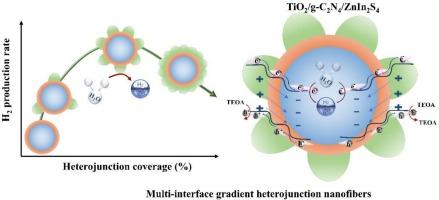Controllable multi-interface coverage of gradient heterojunction nanofibers with one-dimensional structure for photocatalytic hydrogen evolution
IF 6.9
2区 材料科学
Q2 CHEMISTRY, PHYSICAL
引用次数: 0
Abstract
Multi-interface gradient heterojunction nanofibers represent a promising architecture for photocatalytic hydrogen evolution. In this work, such nanofibers were fabricated via electrospinning coupled with secondary growth technology, integrating a spatially separated structure with a core–shell configuration. This design not only establishes host–guest interfaces to facilitate charge separation but also enhances the accessibility of photogenerated electrons and holes during photocatalytic reactions.The simulations indicate that these multi-interface gradient heterojunction nanofibers have an enhanced potential difference (TiO2/g-C3N4/ZnIn2S4 MHNFs: 0.467 V) than core–shell binary heterojunction (TiO2/g-C3N4 HNFs: 0.105 V). Experimentally, the TiO2/g-C3N4/ZnIn2S4 MHNFs have better charge separation and transfer ability, as evidenced by photoluminescence, photovoltage, and photoelectrochemical investigations. The multi-interface exposed multiple reactive sites, and gradient energy band provide an effective photocarrier transfer path, thereby their photocatalytic hydrogen evolution rate was enhanced to 4005.9 μmol g-1 h−1, about 2.5 times higher than that of TiO2/g-C3N4 HNFs with single core–shell interface, and also higher than the other single component sample. This study demonstrates a rational design strategy for high-performance photocatalysts through the construction of multi-interface gradient heterojunction nanofibers, offering effective framework for solar energy conversion applications.

一维结构梯度异质结纳米纤维的可控多界面覆盖光催化析氢
多界面梯度异质结纳米纤维是一种很有前途的光催化析氢结构。在这项工作中,通过静电纺丝结合二次生长技术制备了这种纳米纤维,将空间分离的结构与核壳结构结合在一起。该设计不仅建立了主客体界面以促进电荷分离,而且还提高了光催化反应过程中光生电子和空穴的可及性。模拟结果表明,这些多界面梯度异质结纳米纤维的电位差(TiO2/g-C3N4/ZnIn2S4 MHNFs: 0.467 V)比核壳二元异质结纳米纤维(TiO2/g-C3N4 HNFs: 0.105 V)更大。实验结果表明,TiO2/g-C3N4/ZnIn2S4 MHNFs具有更好的电荷分离和转移能力,并通过光致发光、光电压和光电化学研究证明了这一点。多界面暴露出多个反应位点,梯度能带提供了有效的光载流子转移路径,从而使其光催化出氢速率提高到4005.9 μmol g-1 h−1,比单核壳界面的TiO2/g-C3N4 HNFs高约2.5倍,也高于其他单组分样品。本研究通过构建多界面梯度异质结纳米纤维为高性能光催化剂提供了合理的设计策略,为太阳能转换应用提供了有效的框架。
本文章由计算机程序翻译,如有差异,请以英文原文为准。
求助全文
约1分钟内获得全文
求助全文
来源期刊

Applied Surface Science
工程技术-材料科学:膜
CiteScore
12.50
自引率
7.50%
发文量
3393
审稿时长
67 days
期刊介绍:
Applied Surface Science covers topics contributing to a better understanding of surfaces, interfaces, nanostructures and their applications. The journal is concerned with scientific research on the atomic and molecular level of material properties determined with specific surface analytical techniques and/or computational methods, as well as the processing of such structures.
 求助内容:
求助内容: 应助结果提醒方式:
应助结果提醒方式:


